Introduction
Although Cortina is famous for Christmas holidays, thanks to cinepanettoni, the winter season is more than those two weeks. Snow sports, skiing, delicious meals in restaurants and mountain lodges, and plenty of fun. Let’s discover everything you need to know to make the most of your winter vacation in Cortina.

Downhill Skiing and Snowboarding
Skiing is surely the first thing that comes to mind when thinking about winter in Cortina d'Ampezzo. In this chapter, we'll describe downhill skiing and snowboarding, both of which share the same slopes and are serviced by the same ski lifts.

A sport so central to Cortina deserves special attention: sixty-six slopes extend over one hundred and twenty kilometers, or seventy-five miles. To best serve this skier's paradise, there are thirty-four ski lifts, including cable cars, chairlifts, and gondolas.
The numerous slopes in the area are perfect both for experienced skiers and beginners. Whatever your skill level, you'll surely find the trail that suits you best.

There are plenty of rentals for ski equipment, with expert skiman dedicated to the maintenance and preparation of skis. There is also no shortage of ski schools, offering hundreds of ski instructors to meet every need.
Last but not least, the numerous mountain lodges and bars, often conveniently located directly on the ski slopes. These are perfect spots to relax, soak up the sun, enjoy a "bombardino," or indulge in some après ski to end your day. "Bombardino," also known as "Vov," is an alcoholic thick and sweet cream made with eggs covered by whipped cream. It's typical of the northeast of Italy, and it's delicious.

Surely the most known après ski in Cortina is the Chalet Tofane, but also all the other bars near the ski slopes are a good choice. Here you can have a drink almost without taking off your ski boots and then go back to skiing in no time.
If this chapter has tickled your curiosity and you want more info about skiing in Cortina, you can read our deeper dive below:

 Help us stay ad-free with a small offer.Donate now!
Help us stay ad-free with a small offer.Donate now!
Cross Country Skiing
For those who love contact with nature and tranquility, cross-country skiing is the perfect winter sport.
Cortina offers over seventy kilometers, more than forty miles, of trails for cross-country skiing. Beginners can practice on the simple and flat loops of the training area at the former airport. Those who already master the sport can choose the trail along the former railway, while those seeking a greater challenge can tackle the more technical routes of "Pian de ra Spines" and "Pian de Loa," which pass through the stunning "Dolomiti d'Ampezzo" Natural Park.

The Dolomitic Nordic Ski Center, located in "Fiames," is the focal point for cross-country skiing in Cortina. On-site you can buy the entrance ticket, rent the equipment, and possibly ask for the help of a qualified instructor.
The cross-country skiing center is the starting point for all the trails we mentioned earlier. Alongside them, it also features a bar, which offers a large sun terrace, as well as the opportunity to enjoy refreshments while overlooking the ski slopes.
Cortina is also the finish line of the prestigious "Dobbiaco Cortina," a well-known cross-country ski race that takes place along the former railway track. It allows participants to ski in either classic or skating style for over thirty kilometers, almost twenty miles, ending at the cross-country ski center Nordic Arena in the town of Dobbiaco.

Cross-country ski enthusiasts seeking a more technical challenge should head to the "Tre Croci" Pass. There is a ten-kilometer, or six-mile, trail suitable for both classic and skating styles. This demanding route, recommended only for experienced skiers, is easily accessible from the road leading to the "Tre Croci" Pass.
The cross-country skiing trails of Cortina are part of the Dolomiti Nordicski network, the largest cross-country ski carousel in Europe. With the purchase of the card, you will have access to ski on the trails of eight different areas, including South Tyrol, East Tyrol in Austria, Cortina, and Cadore.
 Help us stay ad-free with a small offer.Donate now!
Help us stay ad-free with a small offer.Donate now!
Mountaineering and Snowshoeing
If you don't like skiing along the ski trails, there are two alternatives if you'd love to go off-track: mountaineering skiing and walking with snowshoes. The snowshoes, in the local dialect, are called "ra ciaspes," and in Italian they are known both as "ciaspole" or "racchette da neve."

Using this equipment, you can enjoy wonderful snow excursions, whether on fresh or compact snow, even in deep conditions. We recommend following well-known and frequented routes, such as those leading to mountain lodges, but, with the necessary precautions, you may also opt for more scenic and less-traveled trails.
If you are looking for inspiration on the best paths, you can find some ideas a little down below in the chapter about winter hikes.

You don't need any particular preparation to tackle the easiest paths, but venturing beyond the most well-known routes requires experience. Alternatively, we recommend being accompanied by an experienced mountaineer or a mountain guide.
Remember that the use of this equipment on traditional ski slopes is strictly prohibited, both during the day and at night. You must also pay close attention to the dangers related to snow movement and to the fact that the snowy landscape can change dramatically. With deep, fresh snow, finding your way can become challenging.
 Help us stay ad-free with a small offer.Donate now!
Help us stay ad-free with a small offer.Donate now!
A Relaxing Stroll
Sometimes we don't want to put on the skis or the snowshoes; we just want to take a stroll. The ideal walk in this case is the former railway former railway of Cortina for many reasons. First of all, it crosses the town from north to south, with tens of entrances. Second, it's a road with a gentle and consistent slope, perfect for relaxing.
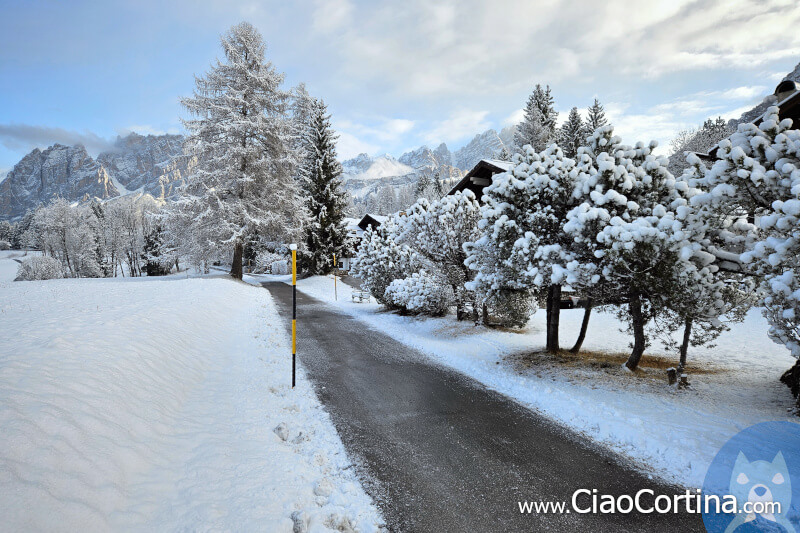
Another reason to choose this walk is that it's regularly cleared of snow, and it's also closed to traffic. If you want more information, we invite you to read our dedicated page below:
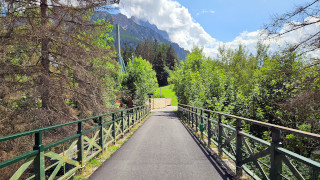
Alternatively, you may explore the lesser-known areas of Cortina along secondary roads without a precise direction. You will surely find some particularly interesting houses or some views to photograph, but do not expect to find commercial activities, apart from a few rare exceptions. Be careful not to enter private properties, which are generally well signed.
And if it's snowing? In this case, your walk to discover the town will become even more suggestive, with the snow creating a magical atmosphere, making everything more romantic.
 Help us stay ad-free with a small offer.Donate now!
Help us stay ad-free with a small offer.Donate now!
Hiking on Packed Snow Trails
If you love walking in the mountains, you might prefer snow paths immersed in nature rather than strolling in the vicinity of the town center. Remember to dress appropriately, with warm, comfortable shoes, and always carry snow crampons to attach to your shoes to avoid slipping on ice.

Compared to summer, the days are shorter, so it’s best to choose relatively short hikes. If you're looking for inspiration, we have collected some of the best and easiest winter hikes, with a mountain lodge as their destination, on the page below:

If you want to try alternative routes, make sure to stick to those designed for pedestrians, staying on the roadside, as you might cross ski mountaineers and snowmobiles. Brightly colored clothing will make you more visible, and in the evening, you should always carry a flashlight. Finally, remember that walking on ski slopes is strictly prohibited.
 Help us stay ad-free with a small offer.Donate now!
Help us stay ad-free with a small offer.Donate now!
A Cable Car Ride
The view of Cortina from above is priceless, especially in winter, when the mountain lodges and lifts are fully open. The easiest way to see a breathtaking panorama is to take the cable car, an activity that we strongly recommend, even if you don't like skiing and winter sports.
Once you reach the top, you can visit the mountain lodges, where you may eat or drink something while observing the incredible panorama and taking some photos. A cable car, in Italian, is called "Funivia."

The most accessible cable car is the "Faloria" cable car. It reaches 2,120 meters, or seven thousand feet, above sea level and is located just a few meters from the Cortina bus station. The cost of the ticket should be more or less €30 round-trip. Right at the arrival of the cable car, you'll find the "Rifugio Faloria" mountain lodge, where you can have a drink or eat something.

As an alternative to Mount Faloria, it's possible to reach the top of Mount Tofane, a very impressive mountain massif 3,244 meters, or 10,600 feet, above sea level. The cable car to Mount Tofane is called the "Freccia nel Cielo" cable car, and its departure is located near the Ice Stadium.
The first stop is at Col Drusciè, 1,778 meters, or 5,833 feet, above sea level, where you will find the restaurant "Col Drusciè" and the Masi Wine Bar Cortina, where you can stop to eat or drink something and enjoy the view. The price of this first round trip is about 20€.
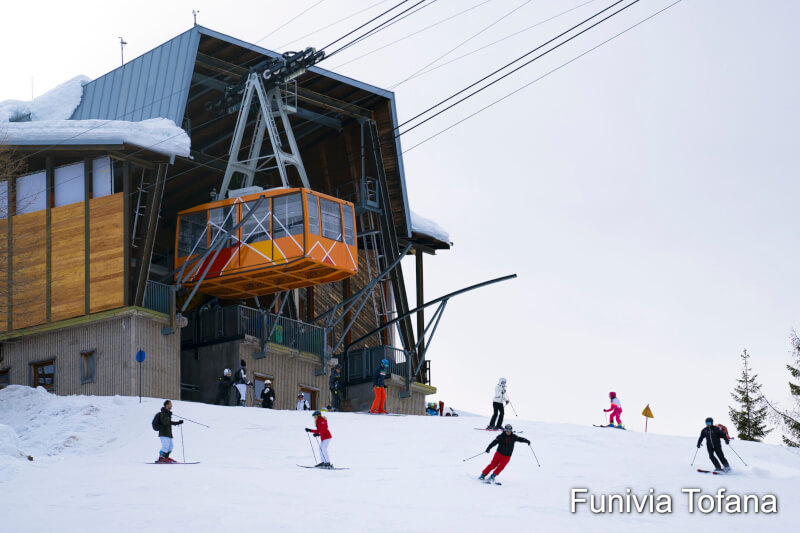
If you want to reach the top, you can take the cable car and continue further; it will cost you an additional €20 round-trip. Be careful though; going 3,000 meters, almost 10,000 feet, is not for everybody. The altitude may cause some dizziness due to the reduced oxygen, and the cold is very biting.
A couple of tips before going up any mountain: dress very well, check the closing time of the cable car, and check the actual opening of the mountain lodges. If you are afraid of heights, you will probably feel a little uncomfortable during the cable car ride because at some points it's really high, but it's really safe. Try to choose a sunny day, and don't forget your sunglasses; the snow can be dazzling.
 Help us stay ad-free with a small offer.Donate now!
Help us stay ad-free with a small offer.Donate now!
Lunch at a Mountain Lodge
Many people think that mountain lodges are unglamorous places where you can eat sausage, polenta, and a glass of wine in an austere hall, warmed up with a wood fire. This is a reality in some places, but you should know that many mountain lodges in Cortina are, in fact, elegant restaurants, with sophisticated menus and modern furnishings.
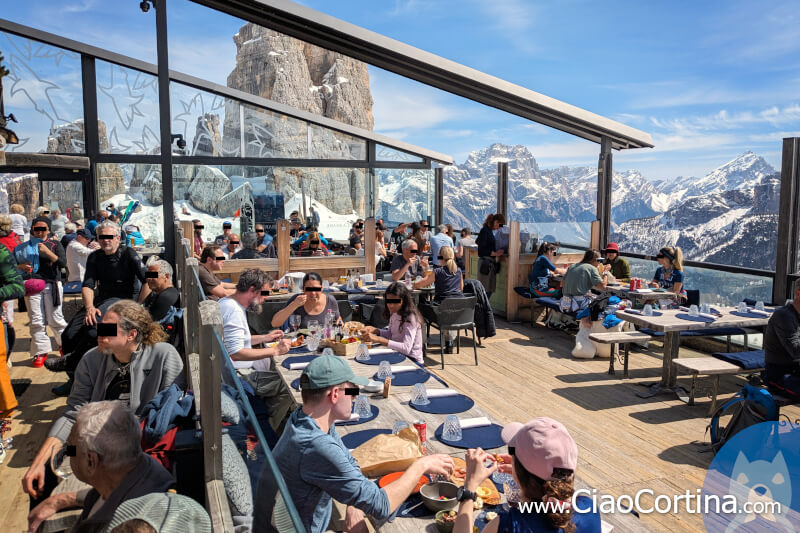
If you are planning to go to have lunch in a mountain lodge, and you want to know what you are getting into, we recommend that you read the in-depth article we wrote for you. You can find it below:

In case you don't want to read the dedicated article, let's summarize quickly. Both in summer and in winter it's possible to reach many mountain lodges by your own strength or by taking a ski lift. It's not necessary to toil to enjoy clean air, a sun terrace, and a great lunch.

There are many mountain lodges that can be reached with the ski lift or with the car, for example, the "Rifugio Scoiattoli," the "Rifugio Faloria," the "Rifugio Averau," the "Rifugio Lagazuoi," the "Rifugio Col Gallina," and many others.
 Help us stay ad-free with a small offer.Donate now!
Help us stay ad-free with a small offer.Donate now!
Dinner at the Lodge With Sledge
Some mountain lodges offer the possibility to have a different and very funny dinner: you reach them on foot or by snowmobile, you eat, drink, and then you go down by sledge, even better if you do it at night. This is an activity that requires sufficient snow, as the sledding trails are not artificially snowed.
The three lodges equipped for this activity are "Malga Federa," the "Rifugio Dibona," and the "Rifugio Mietres." Before planning your dinner, I recommend calling and making a reservation. If you don't have a sled, you can try to ask if they can provide it to you. Alternatively, you can go to any ski rental in the valley, which usually also provides sled rental.

If you decide to venture into this fun activity, don't forget to dress appropriately, with waterproof pants and warm shoes. Other essential things are gloves, a head flashlight with new batteries and a little bit of common sense, because the descent could be dangerous, as the snow may be frozen or you may have exaggerated with schnapps.
We want to repeat it: it's absolutely mandatory to have a head flashlight with you.

If you are more athletic and you want to eat without guilt, we recommend walking up dragging your sledge. Walking on the snow could be quite tiring and slippery, so we recommend to use snow crampons, but it will allow you to do a survey of the slope, increasing your chances of winning the podium in the sled descent.
 Help us stay ad-free with a small offer.Donate now!
Help us stay ad-free with a small offer.Donate now!
A Walk in Corso Italia
The pedestrian area in the heart of the town is called "Corso Italia." Not only is it the beating heart of Cortina d'Ampezzo, but it's also the timeless meeting point for both guests and residents. In addition to featuring the trendiest stores and hotspots, "Corso Italia" is home to many public buildings of historical significance.

To briefly mention the most important structures, it is essential to highlight at least the Parish Church of Cortina and the nearby former town hall; that is also where you can find the tourist information office. We can't also forget to mention the "Cooperativa" of Cortina, one historical shop, which would truly be a shame not to visit at least once.
You may also consider doing some shopping in one of the many stores in the center or take a look at the different artworks exhibited in the art galleries along the Corso.

If after all this shopping you need a break, you can refresh yourself in one of the many bars and pastry shops along "Corso Italia."
This chapter is just a brief mention. If this reading has piqued your curiosity, you might want to read our in-depth article, which can be found below:

 Help us stay ad-free with a small offer.Donate now!
Help us stay ad-free with a small offer.Donate now!
A Drink to Grease the Wheels
The mountains are vacation, and vacation is also having fun. Once you put down your gear, do not let fatigue win. There is a natural remedy to avoid this problem; it's called Aperitiv. Some doctors also recommend some specific recipes, such as the mulled wine to unwind on chilly evenings, or evenings or a classic gin and tonic.
And what if the weather forecast for tomorrow is not the best? In that case, you won't have to get up too early, so you might consider extending the fun to the entire night.

There are different locations to have fun if you want to have some revelry. However, we advise you to avoid drinking too much if you are at high altitudes. Among "mountain people," it's well known that the change of altitude is dangerous: going down in altitude makes the drunkenness rise.
Of course, remember to drink responsibly if you have to drive: if you had one too many, call a cab or take a walk. If you need some suggestions on where to go to party in Cortina, you can read the page below:

 Help us stay ad-free with a small offer.Donate now!
Help us stay ad-free with a small offer.Donate now!
Ice Skating and Hockey
For those who love figure skating, ice skating, and ice hockey, we highly recommend a visit to the Ice Stadium of Cortina. Built during the 1956 Olympics, the ice stadium is frequented by ice skating lovers during the day, while in the evening it hosts the training sessions of S.G. Cortina, the local hockey team. The structure has a skating area of four thousand three hundred square meters and is able to accommodate seven thousand spectators, of which two tousand are in the tribune and five thousand are in the stands.

In 1956 the opening and closing ceremonies of the VII Winter Olympic Games took place in this building. The Olympic flame shone inside the ice stadium for the entire duration of the event. Now the Olympic torch is proudly displayed on the roof of the building, and it's clearly visible from the street.
The opening hours may be varied in order to guarantee the training of the athletes. To make sure you can access it without problems, you should take a look here, at the website of the "Servizi Ampezzo," to check the effective opening of the structure.

For those who love watching hockey matches, it is also possible to support the local hockey team at the ice stadium. SG Cortina is one of the oldest and most successful clubs in Italy; it is also the team that, to date, has the highest number of appearances in the top Italian league. For more information on scheduled matches or to purchase tickets, we invite you to visit the website of the "Sportivi Ghiaccio Cortina."
If you have never seen a match, we recommend you dress with a very warm jacket, winter shoes, and double socks. At the less popular matches, there may not be many people, but you will almost always find a group of loyal fans.
 Help us stay ad-free with a small offer.Donate now!
Help us stay ad-free with a small offer.Donate now!
Other Winter Sports
For lovers of two wheels, the Fat Bikes have made it possible to practice cycling even in winter. Those interested can buy or rent this type of bicycle, which has four or five-inch-wide tires, particularly suitable for pedaling on snow-covered paths. Obviously, such a wide tire makes moving forward more tiring; for this reason, fat bikes are often pedal-assisted.
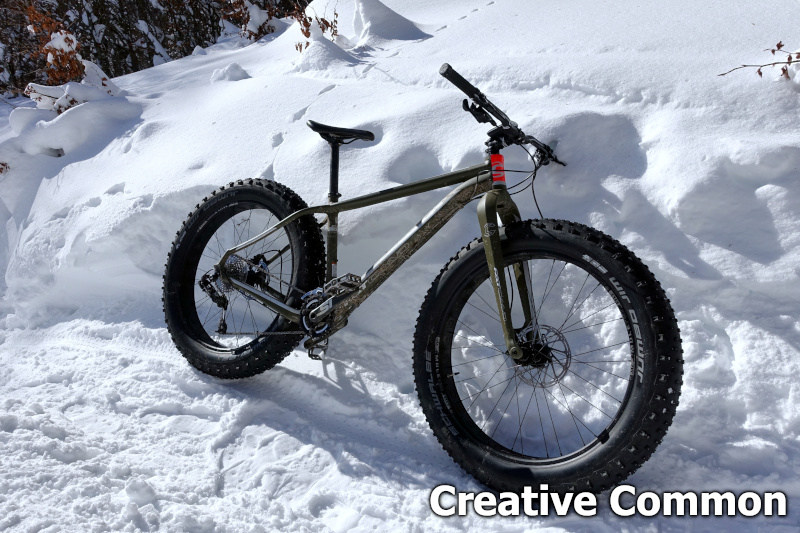
The most adventurous of our readers may even consider the ice climbing. Given the characteristics of the sport, it is essential that the ice be solid, so it is one of those activities that can be done only in the colder months. If you have a passion for climbing and adequate physical preparation, it could be an interesting experience.

As for us, it's one of those things that we wouldn't do even for money. Suffering from vertigo, we don't have the slightest idea how to approach this sport. We can tell you one thing for sure: be accompanied by professionals. The right place to ask for information for both fat biking and ice climbing is the office of the Alpine Guides, which is in the town center. Alternatively, you can also contact the Alpine guides on their official website.
 Help us stay ad-free with a small offer.Donate now!
Help us stay ad-free with a small offer.Donate now!
Winter Season
Cortina d'Ampezzo is one of the most prestigious ski resorts in the world, thanks to the wonderful context in which it is located. It's almost impossible to find another valley so wide, surrounded by mountains of such beauty. Thanks to its undeniable charm, it is literally overrun by tourists who want to spend their winter holidays here.

If you want to know more about touristic trends, don't forget to read our article on the seasonality of Cortina during the year; you can find it below:

If you want to visit Cortina in the peak season, planning is very important. If you want to go skiing or hiking, try to be on the spot early in the morning, even before 8:30 a.m. It will help a lot with parking. If you plan to go eat outside, or you need a ski instructor, or anything else, try to book it well in advance.

The opposite problem will be in the low season. In months like November or after Easter, the chairlifts, cable cars, and even mountain lodges and restaurants could be closed. If you plan to visit Cortina in the low season, we suggest you verify in advance the actual opening of the lifts or business activities before getting there.

As in all mountain resorts, snowfall in winter is inevitable, and sometimes it may be heavy. Cortina is well-prepared to handle snow, but it’s important to remember that heavy precipitation can still cause some inconvenience. Roads and parking lots might be temporarily inaccessible, and during strong winds, ski lifts may be closed for safety reasons.
 Help us stay ad-free with a small offer.Donate now!
Help us stay ad-free with a small offer.Donate now!
Conclusion
We hope you liked this page on the things to do on your winter vacations in Cortina d'Ampezzo. Before saying goodbye, we would suggest you read our home page, with all the articles we wrote about Cortina d'Ampezzo.
If you want to thank us, you can read the page Support Us. If you only want to suggest a change, propose something, or just say hello, in the section Contacts and Info, you'll find all the ways to reach us.


